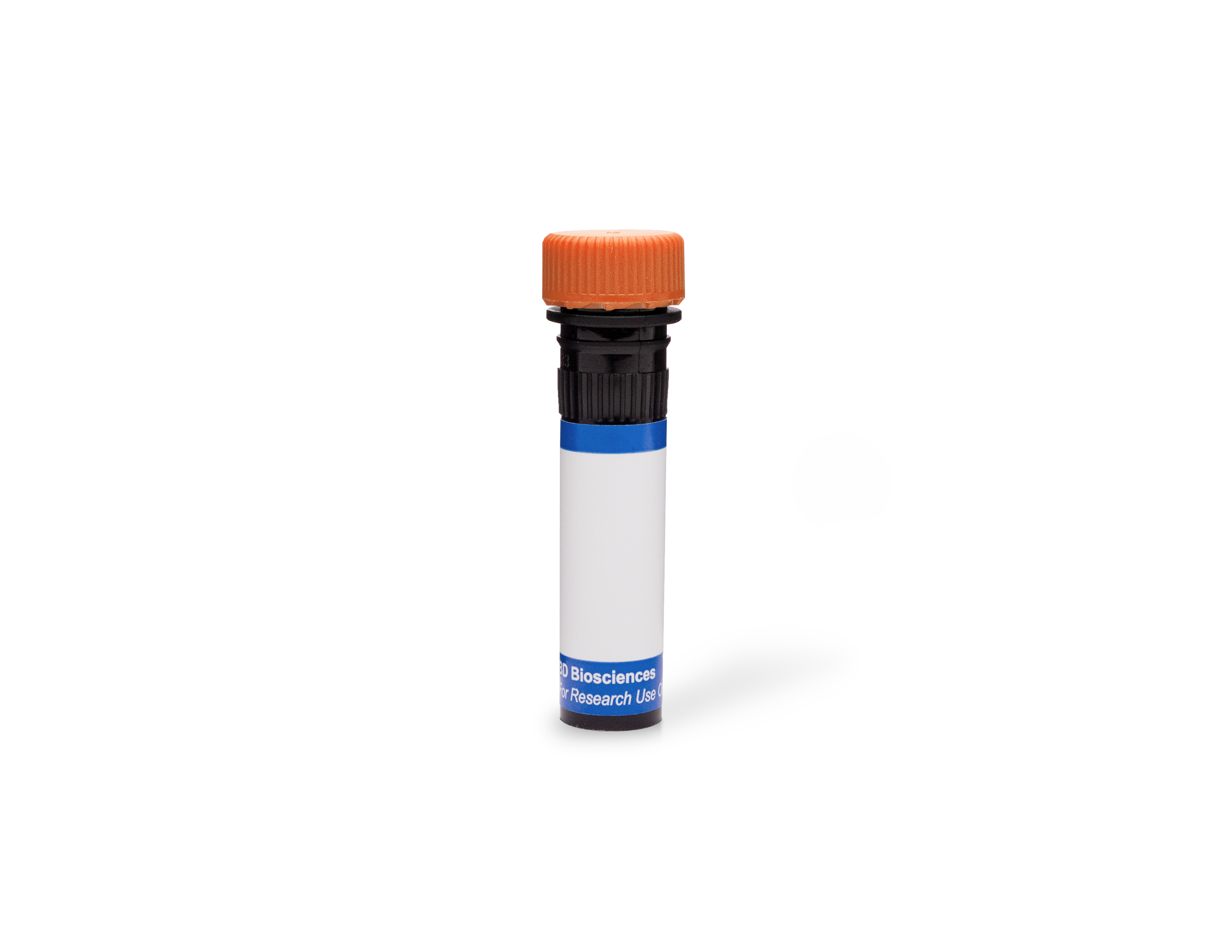


1/2

品牌: BD Pharmingen
 下载产品说明书
下载产品说明书 用小程序,查商品更便捷
用小程序,查商品更便捷



 收藏
收藏
 对比
对比 咨询
咨询反应种属:
Human (QC Testing)
Human (QC Testing)
来源宿主:
Mouse BALB/c IgG2b, κ
Mouse BALB/c IgG2b, κ
产品介绍
产品信息
耦联标记
PE-CF594

微球位置
C8

抗原名称
CD14

宿主
Mouse BALB/c IgG2b, κ

免疫原
Human Monocytes

简单描述
The MΦP9 monoclonal antibody specifically binds to CD14. CD14 is a 53-55 kDa glycosylphosphatidylinositol (GPI)-anchored and single chain glycoprotein expressed at high levels on monocytes. Additionally, this CD14-specific antibody reacts with interfollicular macrophages, reticular dendritic cells and some Langerhans cells. CD14 has been identified as a high affinity cell-surface receptor for complexes of lipopolysaccharide (LPS) and serum LPS-binding protein, LPB. This antibody is suitable for staining acetone-fixed, frozen tissue sections.
This antibody is conjugated to BD Horizon™ PE-CF594, which has been developed exclusively by BD Biosciences as a better alternative to PE-Texas Red®. PE-CF594 excites and emits at similar wavelengths to PE-Texas Red® yet exhibits improved brightness and spectral characteristics. Due to PE having maximal absorption peaks at 496 nm and 564 nm, PE-CF594 can be excited by the blue (488-nm), green (532-nm) and yellow-green (561-nm) lasers and can be detected with the same filter set as PE-Texas Red® (eg 610/20-nm filter).

商品描述
The MΦP9 monoclonal antibody specifically binds to CD14. CD14 is a 53-55 kDa glycosylphosphatidylinositol (GPI)-anchored and single chain glycoprotein expressed at high levels on monocytes. Additionally, this CD14-specific antibody reacts with interfollicular macrophages, reticular dendritic cells and some Langerhans cells. CD14 has been identified as a high affinity cell-surface receptor for complexes of lipopolysaccharide (LPS) and serum LPS-binding protein, LPB. This antibody is suitable for staining acetone-fixed, frozen tissue sections.
This antibody is conjugated to BD Horizon™ PE-CF594, which has been developed exclusively by BD Biosciences as a better alternative to PE-Texas Red®. PE-CF594 excites and emits at similar wavelengths to PE-Texas Red® yet exhibits improved brightness and spectral characteristics. Due to PE having maximal absorption peaks at 496 nm and 564 nm, PE-CF594 can be excited by the blue (488-nm), green (532-nm) and yellow-green (561-nm) lasers and can be detected with the same filter set as PE-Texas Red® (eg 610/20-nm filter).

同种型
Mouse BALB/c IgG2b, κ

克隆号
克隆 MφP9 (also known as MφP-9) (RUO)

产品详情
PE-CF594
BD Horizon™ PE-CF594 dye is a part of the BD PE family of dyes. This tandem fluorochrome is comprised of a R-Phycoerythrin (PE) donor that has excitation maxima (Ex Max) of 496-nm and 566-nm and an acceptor dye with an emission maximum (Em Max) at 615-nm. PE-CF594, driven by BD innovation, is designed to be excited by the blue (488-nm), Green (532-nm) and yellow-green (561-nm) lasers and detected using an optical filter centered near 615 nm (e.g., a 610/20-nm bandpass filter). The donor dye can be excited by the Blue (488-nm), Green (532-nm) and yellow-green (561-nm) lasers and the acceptor dye can be excited by the green (532-nm) laser resulting in cross-laser excitation and fluorescence spillover. Please ensure that your instrument’s configurations (lasers and optical filters) are appropriate for this dye.

PE-CF594
Yellow-Green 488 nm, 532 nm, 561 nm
496 nm, 566 nm
615 nm
应用
实验应用
Flow cytometry (Routinely Tested)

推荐用量
5 µl

反应种属
Human (QC Testing)

目标/特异性
CD14

背景
别名
LPS receptor; LPS-R; Myeloid cell-specific leucine-rich glycoprotein

制备和贮存
存储溶液
Aqueous buffered solution containing BSA and ≤0.09% sodium azide.

保存方式
Aqueous buffered solution containing BSA and ≤0.09% sodium azide.
文献
文献
研发参考(6)
1. Bernstein ID, Self S. Joint report of the Myeloid Section of the Second International Workshop on Human Leukocyte Differentiation Antigens. In: Reinherz EL, Haynes BF, Nadler LM, Bernstein ID, ed. Leukocyte Typing II: Human Myeloid and Hematopoietic Cells. New York, NY: Springer-Verlag; 1986:1-25.
2. Dimitriu-Bona A, Burmester GR, Kelley K, Winchester RJ. Human mononuclear phagocyte differentiation antigens: Definition by monoclonal antibodies, cell distribution, and in vitro modulation. In: Bernard A, Boumsell L, Dausset J, Milstein C, Schlossman SF, ed. Leukocyte Typing. New York: Springer-Verlag; 1984:434-437.
3. Dimitriu-Bona A, Burmester GR, Waters SJ, Winchester RJ. Human mononuclear phagocyte differentiation antigens. I. Patterns of antigenic expression on the surface of human monocytes and macrophages defined by monoclonal antibodies. J Immunol. 1983; 130(1):145-152. (Immunogen: Flow cytometry, Immunofluorescence).
4. Goyert SM, Ferrero E. Biochemical analysis of myeloid antigens and cDNA expression of gp55 (CD14). In: McMichael AJ. A.J. McMichael .. et al., ed. Leucocyte typing III : white cell differentiation antigens. Oxford New York: Oxford University Press; 1987:613-619.
5. Jayaram Y, Hogg N. Surface expression of CD14 molecules on human neutrophils. In: Knapp W. W. Knapp .. et al., ed. Leucocyte typing IV : white cell differentiation antigens. Oxford New York: Oxford University Press; 1989:796-797.
6. Wright SD, Ramos RA, Tobias PS, Ulevitch RJ, Mathison JC. CD14, a receptor for complexes of lipopolysaccharide (LPS) and LPS binding protein. Science. 1990; 249(4975):1431-1433. (Biology).

数据库链接
Entrez-Gene ID
929

参考图片
声明 :本官网所有报价均为常温或者蓝冰运输价格,如有产品需要干冰运输,需另外加收干冰运输费。







 危险品化学品经营许可证(不带存储) 许可证编号:沪(杨)应急管危经许[2022]202944(QY)
危险品化学品经营许可证(不带存储) 许可证编号:沪(杨)应急管危经许[2022]202944(QY)  营业执照(三证合一)
营业执照(三证合一)